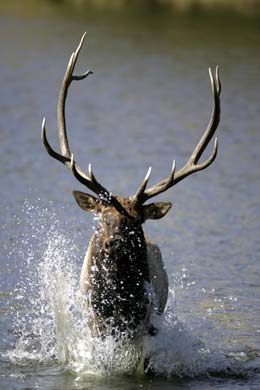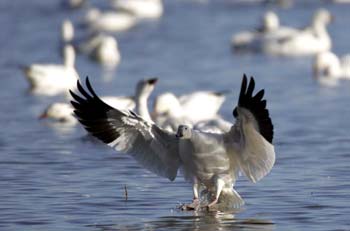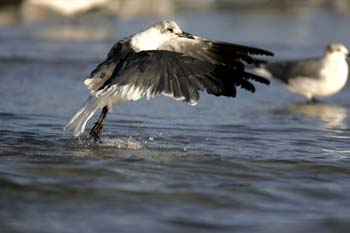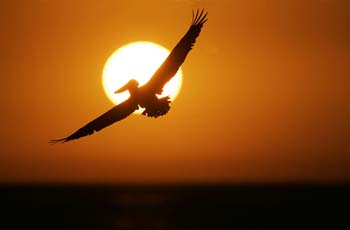
Copyright © Andy Long
It took five trips to Rocky Mountain National Park during the elk rut, before getting a shot I really liked.
Patience is a virtue when shooting wildlife.
Often, when I’m talking with people about doing outdoor photography for a living, their comment is what a dream job it must be. Of course, it’s great having ample opportunities in the field to enjoy the nature and beauty that surrounds us. However, there are also tough parts to the job–even beyond the work of submitting, printing, matting, and everything else on the business side.
One difficult part happens when the wild subjects either aren’t cooperative or aren’t even present. One of my favorite places to go throughout the year in my home state of Colorado is Rocky Mountain National Park. Since it’s just a ninety-minute drive from my house, I make the journey at least ten times a year. Unfortunately, I’ve journeyed to the park plenty of times when I never bothered to take my camera out of the bag. The animals just weren’t around to have their photos taken. Everyone has experienced similar disappointments.
The more times you go into the field, the more chances you have of striking out. Of course, if your trip is nature-related as opposed to being focused solely on wildlife, you’ll always find something to shoot. But, if the outing is strictly for wildlife, there’s a good chance you’ll go home empty-handed, even when your destination is one of the top locations in the country for the amount and variety of subjects usually available.
During a recent trip to Bosque del Apache National Wildlife Refuge in New Mexico, I never found what had previously been very reliable action featuring sandhill cranes and snow geese. A new refuge manager had made changes that caused the birds to move to other locations instead of their normal haunts. The main lake was half emptied, so great morning shots of thousands of snow geese taking flight were not available. A search for a different sunrise spot was necessary. In addition, a pond that had been quite productive for the first several nights was quickly being drained, and numerous grain fields hadn’t been planted. Again, both the birds and photographers had to relocate.

Copyright © Andy Long
Luckily, the timing worked out for getting this snow goose landing on the water, as the next evening the water was being drained from the pond and the birds weren’t coming in.
There are several ways to look at your situation when you strike out. The first is to just enjoy being wherever you are and take in the surrounding beauty. You could pull out a smaller lens and shoot landscape shots or look for some interesting, intimate landscapes of small parts of nature. However, just enjoying being out there can be fulfilling enough.
When you think about it, not many people can or do take the time to view the natural world around us. A frustrating day of not finding wildlife tops the experiences of many other people who rarely leave their homes. There are numerous bumper stickers that express the gift of being outdoors. One says, “A bad day of fishing is better than a good day at work.” Every day we spend in the field in hopes of getting that great shot is always a great day, even if the great shot doesn’t happen.
Another way of looking at the situation is to examine the statistics. In baseball, a player is considered great if he has a batting average around .300 for his career (which means he failed to produce almost 70 percent of the time). A wildlife photographer’s percentage has to be much higher than that, so occasional strike-outs have to be expected from time to time.
A way to take advantage of a slow day when the animals are too far away to photograph is to observe animal behavior. Put the big lens on and just watch. You can always learn something new about animal behavior, and anything you learn may help later on when you’re close enough to get good photos–especially great action shots. Many times an animal gives a clue as to what it’s about to do. Knowing what to watch for ahead of time can mean the difference between getting a great shot and missing the peak of action. For example, on a recent trip to Florida, I was able to capture some nice action shots of gulls and skimmers lifting off from the water by knowing what they do just before they take flight. The more you watch and pay attention to the behavior of your subject, the more great shots you’re going to carry home.

Copyright © Andy Long
Having spent time watching gull behavior, I knew their movements prior to taking off from the water, so I was prepared to catch the shot.

Copyright © Andy Long
I’ve had an image of a large bird in front of the sun in my mind for quite a few years, but was never afforded the opportunity. A trip to Florida finally provided it.
We have to remember that wildlife is wild. While many creatures can be fairly predictable, they don’t have to go to the same place every year or do the same thing at the same time every day. Yes, putting up a bird feeder can pretty much guarantee having birds there every day, and Alaska brown bears will be near a creek or river during the salmon run, but sometimes things change. A drop in the number of salmon returning to spawn (due to over-fishing) will cause bears to seek out a new place to fish. Elk might decide to find a new meadow in which to gather a harem during the rut season or stay on the back side of a large meadow that you can’t access.
A final way to use “down” time is to travel back roads you haven’t explored before. Who knows, there might be something there or you can learn if it might be more productive at another time. You have to find new spots to go, anyway, so why not use a slow day to see what else is nearby? You might discover a species other than the one you usually shoot.
by Andy Long

Leave a Reply